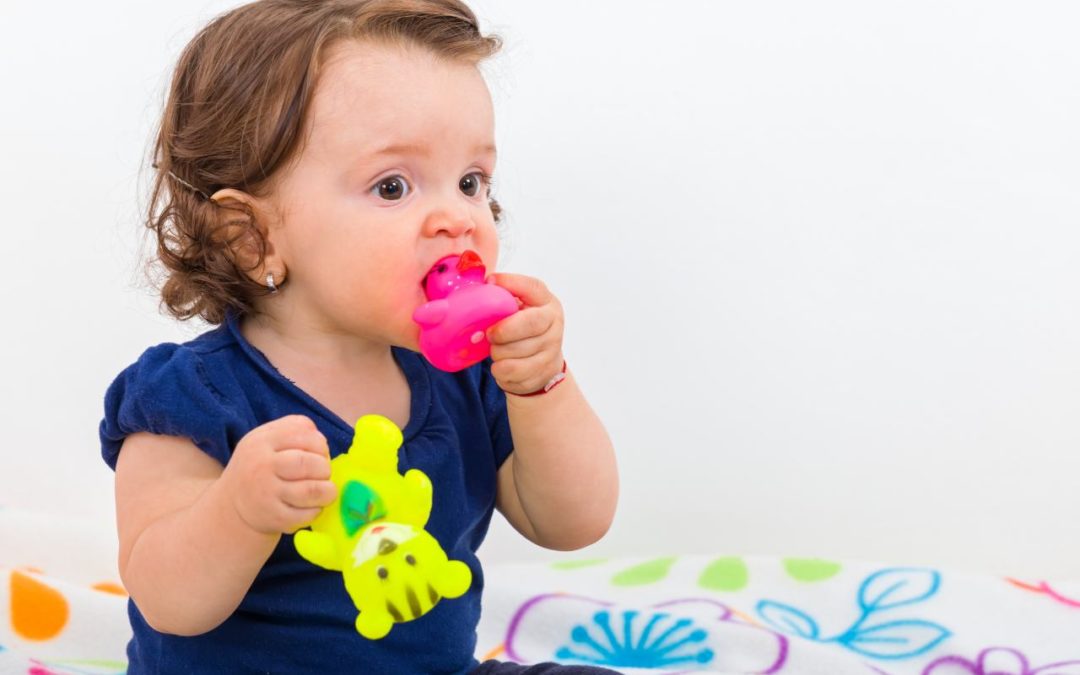Any parent or guardian with kids, remembers the scary toddler phase where everything in reach is on their non-discerning mental list of things to chew on. The phase when they pick up everything, and to learn about it, they pop it into their mouth. Little toys, scraps of forgotten food that fell off the table at mealtime, a rubber band. Anything. We all breathe easier when that phase passes. And yet, as our kids get older, some of them continue chewing on things. You might catch them chewing on a pencil, or a pen. Biting nails is a common occurrence, and crunching ice also seems popular. Maybe the neckline or cuff of their shirtsleeve seems to be irresistible. That last one can really have parents wondering, “what causes a child to chew on clothes?”
Why Do They Chew on Stuff?
There are a variety of reasons behind kids chewing on non-food things, some reasons include:
Anxiety or stress – the act of chewing as a soothing activity goes back to the days of being a baby when sucking was an act to self soothe.
Sensory needs – chewing is relatively common as a soothing activity for children with sensory issues.
Concentration – the repetition of chewing can help focus and block outside distractions
Habit – chewing can be a habit born of boredom and convenience because there is always something available to chew on (pencils, clothing, hair, etc.)
Is Chewing Bad?
The act of chewing is not in and of itself a bad thing. Chewing stimulates the flow of saliva in your mouth. Saliva is the frontline defense in your mouth against tooth decay and plaque. According to the American Dental Hygienists’ Association (ADHA), “Saliva contains important elements such as bicarbonate, calcium, and phosphate. They not only neutralize plaque acids, but also help repair early tooth damage and decay.”
Problems come into play with chewing when the object being chewed is a non-food item. We then can become concerned for safety (choking hazards), concerned for what is socially acceptable (wet shirt sleeves or torn bloody fingernails), and concerned for the health of their teeth (cracked or chipped tooth or a loose dental filling).
Does Ice Count as a Non-Food Item?
Chewing ice is a common habit among kids, teens, and adults. And it is unequivocally, a bad habit. Ice is very hard and possesses the ability to crack or chip your teeth. Our composite fillings that we use on teeth that have cavities can have lifespans of up to ten years or more when properly cared for, but are vulnerable to damage caused from habitually chewing ice. It is painful to lose a filling and usually means an immediate trip to the dentist for replacement. Additionally, any brackets or retainer wires can be dislodged from teeth and damaged by chewing ice. We don’t want that for your kid any more than you do.
How Should You Respond When You See Your Child Chewing Non-Food Items or Ice?
Keep in mind that their chewing habit may not be a conscious one. Do they do it when they seem nervous or stressed? Do they have other sensory issues? Try to point out the habit without judgment and resist any inclination to shame them from doing it. Shaming the habit could lead them to hide it from you but continue the behavior or do it as a form of rebellion. If you believe it to be a sensory issue, consult with their pediatrician. If it is a soothing technique for stress or anxiety, consider talking to them about other coping techniques or consult their pediatrician or school guidance counselor. Provide your child with age appropriate information about the dangers of chewing on non-food items and ice.
Is Chewing Gum Bad?
Chewing gum can be good for your child’s dental hygiene after meals. There are, however, qualifiers. Firstly, if your child has braces or a retainer or TMJ disorder, then chewing gum is a bad idea. The gum will stick to the hardware and be not only a pain to get cleaned but can damage the wires or brackets. For kids with TMJ disorder, chewing gum can cause more frequent headaches and jaw pain. Secondly, the gum must be sugarless.
According to the American Dental Association (ADA), “Research shows that chewing sugarless gum for 20 minutes following meals can help prevent tooth decay. That is because the act of chewing increases the flow of saliva in your mouth, which helps neutralize and wash away cavity-causing acids and bacteria. Over time, acids can wear away tooth enamel, creating ideal conditions for decay. Look for chewing gum with the ADA Seal to be sure it can help prevent cavities.”
For Your Kids Who Like to Chew
If you have a kid that likes to chew on things, consider serving up crunchy snacks. Carrot sticks, celery sticks, and crunchy apple slices are healthy snacks that can satisfy the chewing urge. Nuts are also a great snack. Read our blog post Do-Eats and Don’t-Eats for Kids to Promote Healthy Teeth for more ideas about healthy snacks, and to read about why some of those crunchy foods are also good for teeth.
But Wait!
Yes, we are saying chewing sugarless gum can help with dental hygiene but it in no way should be used as a substitute for brushing and flossing! Morning and nighttime routines of brushing for two minutes and flossing at least once daily are vital to your child having a healthy smile.

